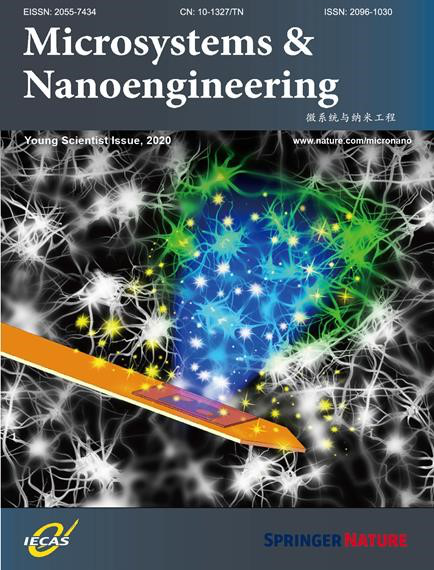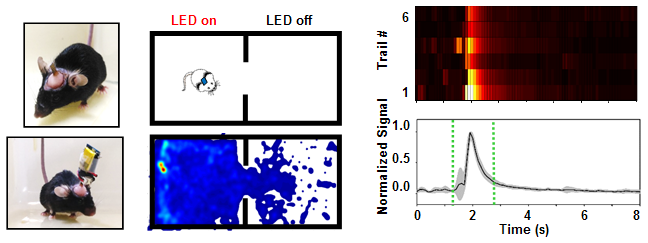On August 24, the Sheng Xing Research Group of the Department of Electronic Engineering, Tsinghua University published a research paper titledA wireless, implantable optoelectrochemical probe for optogenetic stimulation and dopamine detection. The research group has developed a micro-thin-film-device-based wirelessly controlled, optoelectrochemical probe to realize optogenetic stimulation and electrochemical detection of animal deep brain regions. This research result can realize the two-way information interaction between the nervous system and the interface device, and provide effective technical means for the in-depth study of the action mechanism of neural circuits and the cracking of the pathogenesis of neurological diseases. The paper was published inMicrosystems & Nanoengineering, a journal jointly published by Nature and Chinese Academy of Sciences, and was selected as the cover paper byYoung Scientist Issue.

Photo 1. Journal cover
Compared with traditional neuroscience research methods (including electrical stimulation and drug stimulation, and so on), the optogenetics has two unique characteristics of high temporal-spatial resolution and cell type specificity, which provides a revolutionary research tool for the neurology field, and is widely used in neuroscience research. In addition to nerve stimulation, the detection of neural signals is also an important means of neuroscience research. Among many neural signals, neurotransmitters such as dopamine are closely related to the ideology and physiological behavior of organisms. The detection of neurotransmitters is of great significance to reveal the pathogenesis of neurological diseases. Identifying the relationship between neurotransmitter release and neuron stimulation is crucial for understanding the disease cause and developing precise treatments.
The work proposed a design idea of a wireless micro-thin-film-device-based implantable optoelectrochemical probe. A poly (3,4-ethylenedioxythiophene) polystyrene sulfonate (PEDOT:PSS)-coated diamond film is placed on the micro-LED, serving as an electrochemical sensor with high sensitivity, optical transparency, and good heat dissipation. At the same time, a micro-LED is used as an implantable light source; A set of efficient heterogeneous substrate integration process has been designed to realize the stacking and integration of micro-LED and electrochemical sensors on flexible substrates. Through the optimization of device packaging and the design of heat dissipation structure, obtaining the implantable optoelectrochemical probe. At the same time, a wirelessly operated, miniaturized circuit matching the optoelectrochemical probe has been developed to realize the remote optical control of the neural circuits and electrochemical data acquisition.

Photo 2. Schematic diagram of the optoelectrochemical probe, and its optical and electrochemical performance test
In experiments performed in vivo, the dopamine detection limit concentration of the multifunctional probe is about 0.1uM, and the design of the heat dissipation structure reduces the surface temperature of the micro-LED by 50%, which meets the requirements of in vivo experiments. In the ventral tegmental area (VTA) of the midbrain of experimental mice, the optogenetic stimulation and electrochemical detection functions of the multifunctional probe were verified. Through the wireless transmission system, the remote optogenetic control of mouse behavior can be realized, the animal's position preference can be changed, and the spontaneous dopamine neurotransmitter release signal can also be successfully captured. The in vivo experiment results showed that the optoelectrochemical probe has the remote, real-time optogenetic stimulation and electrochemical detection functions. The research provides technical support for the exploration of the relationship between neuronal activities and neurotransmitter release, and the in-depth research of the mechanism of neural circuits.

Photo 3: In vivo experimental results of the optoelectrochemical probe
The corresponding author of this paper is Associate Professor Sheng Xing from the Department of Electronic Engineering, Tsinghua University (also a part-time researcher at the IDG/McGovern Institute for Brain Research, Tsinghua University), the first author Liu Changbo was formerly a postdoctoral fellow at the Department of Electronic Engineering (now teaching at Beihang University), and the collaborators include the research group of Professor Zou Guisheng and Associate Professor Liu Lei from the Department of Electronic Engineering, Tsinghua University, the research group of Associate Professor Yin Lan from School of Materials Science and Engineering, Tsinghua University, and the research group of Sun Qian from Suzhou Institute of Nano-Tech and Nano-Bionics, Chinese Academy of Sciences, and so on. The work was supported by projects such as National Natural Science Foundation of China, Beijing National Research Center for Information Science and Technology, and the Innovation Cross-disciplines Team of Chinese Academy of Sciences.
Paper link: https://www.nature.com/articles/s41378-020-0176-9